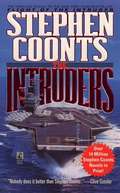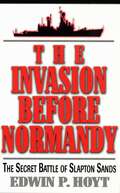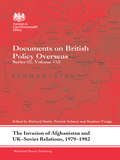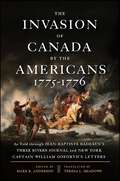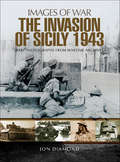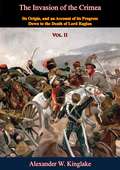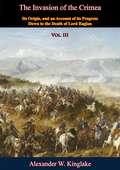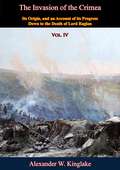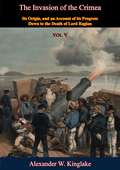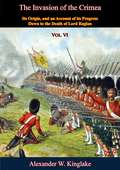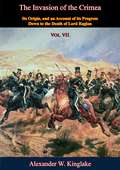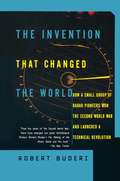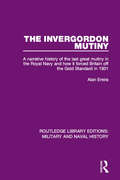- Table View
- List View
The Intruders (Jake Grafton #1)
by Stephen CoontsIn this thriller from a New York Times–bestselling author, Vietnam is over for a Navy pilot—but danger remains in the form of Soviet MiGs and Sumatran pirates. Fighter pilot Jake Grafton is adrift following combat in Vietnam. With no place in the States to call home, Grafton sticks to what he knows best: taking on the world&’s most treacherous skies from the cockpit of a Grumman A-6 Intruder. Now, stationed in the South Pacific on the U.S.S. Columbia, Grafton must teach the Marines aboard the art of flying from an aircraft carrier—a mission that, thanks to the unruly Marine Captain Le Beau, is as joyless as it is dangerous. But when an unexpected enemy appears from above, Grafton and Le Beau must put aside their differences and work together to save the lives of all onboard.This ebook features an illustrated biography of Stephen Coonts, including rare photos from the author&’s personal collection.
The Intruders (Jake Grafton #6)
by Stephen Coonts1973. The Vietnam War is finally over, but for Lieutenant Jake Grafton, U.S.N., freshly returned from two harrowing combat cruises, his own country seems almost as hostile. When his fists get him into trouble, he lands an excruciating eight-month cruise on the aircraft carrier COLUMBIA teaching Jarheads--Marines--the nuances of carrier aviation. As a Navy man working beside Marines without carrier aviation experience, Grafton's about to discover another world of fresh hell. Taking off and landing from a slippery flight deck, on a choppy sea in a pitch-black night, there is no room for error--or for animosity. And while these Marines have Jake wishing he was back fighting the VC, he'll have to learn to live with them. For they must fly together in the same cockpit, must lock into each other and into their million-dollar machines, and make the split-second decisions that hurtle them toward their common goals: excellence and survival.
The Invasion Before Normandy: The Secret Battle of Slapton Sands
by Edwin P. HoytA chronicle of one of WWII's most dramatic and secret operations.
The Invasion Before Normandy: The Secret Battle of Slapton Sands (Lyons Press Library of WWII)
by Edwin P. HoytThe Invasion Before Normandy is a chronicle of one of World War II's most dramatic and secret operations. In 1944, an American naval exercise off the southern Devonshire coast—preparation for the landing at Normandy—was interrupted by the sudden appearance of German E-boats. When the fighting was over, 198 Navy men and 441 soldiers were counted among the dead. Quickly covered up by military officials who needed to protect the invasion plans, these casualties were lumped together with those from Omaha Beach and the results of the failed mission were hidden for the next forty years. This book provides a rare inside look at this catastrophic rehearsal for D-Day.
The Invasion of Afghanistan and UK-Soviet Relations, 1979-1982: Documents on British Policy Overseas, Series III, Volume VIII (Whitehall Histories)
by R. A. Smith P. Salmon S. TwiggeThis volume examines British policy towards the Soviet Union in the aftermath of the invasion of Afghanistan in December 1979. The documents in this volume, many released into the public realm for the first time, describe the development of British policy towards the Soviet Union during the eventful years 1979-1982. The new Conservative government, under Margaret Thatcher, was determined to strengthen British defences against the perceived Soviet threat and advocated a strong response to the Soviet intervention. East-West relations further deteriorated following the imposition of martial law in Poland in December 1981. The dilemma facing the British government was how to express strong disapproval of Soviet actions while still attempting to maintain a constructive bilateral relationship, and at the same time keep British policy in line with the Western Alliance. The death of President Brezhnev in November 1982, after 18 years in office, brought uncertainty but also new opportunities for relations with the Soviets. This book will be of much interest to students of British politics and foreign policy, Russian history, US foreign policy, Central Asian politics, and IR in general.
The Invasion of Canada by the Americans, 1775-1776: As Told through Jean-Baptiste Badeaux's Three Rivers Journal and New York Captain William Goforth's Letters
by Mark R. Anderson; Teresa L. MeadowsThe Invasion of Canada by the Americans, 1775–1776 offers two significant, insightful, and intriguing first-hand accounts of the Revolutionary War. These previously untranslated and unpublished primary sources provide contrasting viewpoints from a Loyalist French-Canadian administrative official, Jean-Baptiste Badeaux, and a Patriot Continental officer, William Goforth. Compelling personal interactions with friends and neighbors, and local and provincial-level leaders—as occupier and occupied—are documented. Their stories climax during the two-month period in early 1776 when Goforth was military governor of Three Rivers and Badeaux served as his somewhat reluctant interpreter and unofficial advisor. Including their experiences with Benedict Arnold and Quebec's Governor Guy Carleton, as well as letters to Benjamin Franklin and John Jay, this unique book provides diverse insights into the invasion of Canada and its immediate impact on the people on both sides of the revolution.
The Invasion of France, 1814
by Captain Frederick William O. Maycock, D.S.O.This ebook is purpose built and is proof-read and re-type set from the original to provide an outstanding experience of reflowing text for an ebook reader. Beset along the northern border of France by enemies that out-numbered him by at least five to one, where ordinary generals might have despaired, Napoleon went on to win a remarkable series of victories that recalled the rapidity of his brightest early campaigns. Although not enough to turn the tide of the Allies march on Paris, they are hugely important for the methods used by the Emperor in his last campaign before Waterloo. Turning on isolated parts of the Prussian Field Marshal Blücher's army, composed of both Russians and Prussians, Napoleon won the battles of Champaubert, Montmirail, Château-Thierry and Vauchamps, inflicting nearly 20,000 casualties for a loss of 3,000 of his own men. However, this magic could not last... A well-known and respected writer on the Napoleonic Wars, Captain Maycock's work is a fine addition to any bookshelf on a much neglected campaign. This book is part of the Special Campaigns series produced around the turn of the 20th century by serving or recently retired British and Indian Army officers. They were intended principally for use by British officers seeking a wider knowledge of military history. Title - The Invasion of France, 1814 Series Name - Special Campaigns Series Series Number -- 21 Author -- Captain Frederick William O. Maycock, D.S.O. (1877-????) Text taken, whole and complete, from the edition published in 1907, London, by Longmans and Green. Original - xv and 238 pages. Illustrations - The maps cannot be reproduced with this volume as they are A3.
The Invasion of Sandy Bay
by Anita SanchezA young boy plays a key role when the War of 1812 comes to his Massachusetts coastal fishing village. The little town of Sandy Bay, Massachusetts, was the site of one of the wildest invasions in U.S. history, when the might of the British Empire came up against hardheaded New England townsfolk. The Invasion of Sandy Bay, based on eyewitness accounts of actual events, tells the tale--through the eyes of a twelve-year-old boy--of what happened on the night when the British put too much gunpowder in one of their cannons. <P><P> The hilarious--and true--events of the topsy-turvy invasion are set against the backdrop of the dangerous lives of the fishermen. Includes author's notes and bibliography.
The Invasion of Sicily 1943 (Images of War)
by Jon Diamond Dr.With victory in North Africa complete, the Allies had a choice. The Americans wanted an early cross channel attack from Britain on North West Europe. Churchill favored invading the soft underbelly of Italy to weaken the Axis forces and gain Italian surrender. With Eisenhowers army and battle-hardened Eighth Army in North Africa, Churchill prevailed.The ambitious Operation HUSKY required meticulous planning. Montgomery's Eighth Army and Patton's Seventh landed successfully although the air landing proved costly. While the outcome was not in doubt the mountainous terrain acted in the defenders favor. The German presence was higher than expected and the vast bulk of the enemy were Italian. In little over a month, the first Americans reached Messina.The strategic plan was successful: the Italian capitulated, Hitler had to reinforce his Southern flank relieving pressure on the Soviets and valuable lessons were learned by Allied for D-Day.
The Invasion of Sicily 1943 (Images of War)
by Jon Diamond Dr.With victory in North Africa complete, the Allies had a choice. The Americans wanted an early cross channel attack from Britain on North West Europe. Churchill favored invading the soft underbelly of Italy to weaken the Axis forces and gain Italian surrender. With Eisenhowers army and battle-hardened Eighth Army in North Africa, Churchill prevailed.The ambitious Operation HUSKY required meticulous planning. Montgomery's Eighth Army and Patton's Seventh landed successfully although the air landing proved costly. While the outcome was not in doubt the mountainous terrain acted in the defenders favor. The German presence was higher than expected and the vast bulk of the enemy were Italian. In little over a month, the first Americans reached Messina.The strategic plan was successful: the Italian capitulated, Hitler had to reinforce his Southern flank relieving pressure on the Soviets and valuable lessons were learned by Allied for D-Day.
The Invasion of the Crimea: Its Origin, and an Account of its Progress Down to the Death of Lord Raglan (The Invasion of the Crimea #1)
by Alexander W. KinglakeThis is the sixth edition of the first volume in a series of nine that was originally published in 1877, and which together provide a thoroughly comprehensive operational history of the Crimean War to June 1855, including all the early battles and the first attack on the Redan.Alexander William Kinglake (1809-1891) visited the Crimea in 1854 as a civilian and was present at the battle of the Alma (20 Sep 1854). The British Commander-in-Charge, Lord Raglan, suggested to Kinglake that he write a history of the Crimean War and made available all his private papers. The result is this monumental and elaborate piece of work, which tells the story of the war from its very origins right through to the death of Raglan on 28 June 1855, at which point the conflict still had another eight months to run until its conclusion at the Treaty of Paris on 28 February 1856…This FIRST volume takes a detailed look at the ORIGIN OF THE WAR OF 1853 BETWEEN THE CZAR AND THE SULTAN.Richly illustrated throughout with useful maps and diagrams.
The Invasion of the Crimea: Its Origin, and an Account of its Progress Down to the Death of Lord Raglan (The Invasion of the Crimea #2)
by Alexander W. KinglakeThis is the sixth edition of the second volume in a series of nine, originally published in 1877, which together provide a thoroughly comprehensive operational history of the Crimean War to June 1855, including all the early battles and the first attack on the Redan.Alexander William Kinglake (1809-1891) visited the Crimea in 1854 as a civilian and was present at the battle of the Alma (20 Sep 1854). The British Commander-in-Charge, Lord Raglan, suggested to Kinglake that he write a history of the Crimean War and made available all his private papers. The result is this monumental and elaborate piece of work, which tells the story of the war from its very origins right through to the death of Raglan on 28 June 1855, at which point the conflict still had another eight months to run until its conclusion at the Treaty of Paris on 28 February 1856…This SECOND volume takes a detailed look at the CAUSES INVOLVING FRANCE AND ENGLAND IN THE WAR AGAINST RUSSIA.Richly illustrated throughout with useful maps and diagrams.
The Invasion of the Crimea: Its Origin, and an Account of its Progress Down to the Death of Lord Raglan (The Invasion of the Crimea #3)
by Alexander W. KinglakeThis is the sixth edition of the third volume in a series of nine that was originally published in 1877, and which together provide a thoroughly comprehensive operational history of the Crimean War to June 1855, including all the early battles and the first attack on the Redan.Alexander William Kinglake (1809-1891) visited the Crimea in 1854 as a civilian and was present at the battle of the Alma (20 Sep 1854). The British Commander-in-Charge, Lord Raglan, suggested to Kinglake that he write a history of the Crimean War and made available all his private papers. The result is this monumental and elaborate piece of work, which tells the story of the war from its very origins right through to the death of Raglan on 28 June 1855, at which point the conflict still had another eight months to run until its conclusion at the Treaty of Paris on 28 February 1856…This THIRD volume takes a detailed look at the ORIGIN OF THE WAR OF 1853 BETWEEN THE CZAR AND THE SULTAN.Richly illustrated throughout with useful maps and diagrams.
The Invasion of the Crimea: Its Origin, and an Account of its Progress Down to the Death of Lord Raglan (The Invasion of the Crimea #4)
by Alexander W. KinglakeThis is the sixth edition of the fourth volume in a series of nine that was originally published in 1877, and which together provide a thoroughly comprehensive operational history of the Crimean War to June 1855, including all the early battles and the first attack on the Redan.Alexander William Kinglake (1809-1891) visited the Crimea in 1854 as a civilian and was present at the battle of the Alma (20 Sep 1854). The British Commander-in-Charge, Lord Raglan, suggested to Kinglake that he write a history of the Crimean War and made available all his private papers. The result is this monumental and elaborate piece of work, which tells the story of the war from its very origins right through to the death of Raglan on 28 June 1855, at which point the conflict still had another eight months to run until its conclusion at the Treaty of Paris on 28 February 1856…This FOURTH volume takes a detailed look at SEBASTOPOL AT BAY.Richly illustrated throughout with useful maps and diagrams.
The Invasion of the Crimea: Its Origin, and an Account of its Progress Down to the Death of Lord Raglan (The Invasion of the Crimea #5)
by Alexander W. KinglakeThis is the sixth edition of the fifth volume in a series of nine that was originally published in 1877, and which together provide a thoroughly comprehensive operational history of the Crimean War to June 1855, including all the early battles and the first attack on the Redan.Alexander William Kinglake (1809-1891) visited the Crimea in 1854 as a civilian and was present at the battle of the Alma (20 Sep 1854). The British Commander-in-Charge, Lord Raglan, suggested to Kinglake that he write a history of the Crimean War and made available all his private papers. The result is this monumental and elaborate piece of work, which tells the story of the war from its very origins right through to the death of Raglan on 28 June 1855, at which point the conflict still had another eight months to run until its conclusion at the Treaty of Paris on 28 February 1856…This FIFTH volume takes a detailed look at THE BATTLE OF BALACLAVA.Richly illustrated throughout with useful maps and diagrams.
The Invasion of the Crimea: Its Origin, and an Account of its Progress Down to the Death of Lord Raglan (The Invasion of the Crimea #6)
by Alexander W. KinglakeThis is the sixth edition of the sixth volume in a series of nine that was originally published in 1877, and which together provide a thoroughly comprehensive operational history of the Crimean War to June 1855, including all the early battles and the first attack on the Redan.<P><P> Alexander William Kinglake (1809-1891) visited the Crimea in 1854 as a civilian and was present at the battle of the Alma (20 Sep 1854). The British Commander-in-Charge, Lord Raglan, suggested to Kinglake that he write a history of the Crimean War and made available all his private papers. The result is this monumental and elaborate piece of work, which tells the story of the war from its very origins right through to the death of Raglan on 28 June 1855, at which point the conflict still had another eight months to run until its conclusion at the Treaty of Paris on 28 February 1856…<P> This SIXTH volume takes a detailed look at THE BATTLE OF INKERMAN.
The Invasion of the Crimea: Its Origin, and an Account of its Progress Down to the Death of Lord Raglan (The Invasion of the Crimea #7)
by Alexander W. KinglakeThis is the sixth edition of the fourth volume in a series of nine that was originally published in 1877, and which together provide a thoroughly comprehensive operational history of the Crimean War to June 1855, including all the early battles and the first attack on the Redan.Alexander William Kinglake (1809-1891) visited the Crimea in 1854 as a civilian and was present at the battle of the Alma (20 Sep 1854). The British Commander-in-Charge, Lord Raglan, suggested to Kinglake that he write a history of the Crimean War and made available all his private papers. The result is this monumental and elaborate piece of work, which tells the story of the war from its very origins right through to the death of Raglan on 28 June 1855, at which point the conflict still had another eight months to run until its conclusion at the Treaty of Paris on 28 February 1856…This FOURTH volume takes a detailed look at SEBASTOPOL AT BAY.Richly illustrated throughout with useful maps and diagrams.
The Invasion of the Crimea: Its Origin, and an Account of its Progress Down to the Death of Lord Raglan (The Invasion of the Crimea #8)
by Alexander W. KinglakeThis is the sixth edition of the eighth volume in a series of nine that was originally published in 1877, and which together provide a thoroughly comprehensive operational history of the Crimean War to June 1855, including all the early battles and the first attack on the Redan.<P><P> Alexander William Kinglake (1809-1891) visited the Crimea in 1854 as a civilian and was present at the battle of the Alma (20 Sep 1854). The British Commander-in-Charge, Lord Raglan, suggested to Kinglake that he write a history of the Crimean War and made available all his private papers. The result is this monumental and elaborate piece of work, which tells the story of the war from its very origins right through to the death of Raglan on 28 June 1855, at which point the conflict still had another eight months to run until its conclusion at the Treaty of Paris on 28 February 1856…<P> This EIGHTH volume takes a detailed look at THE MORROW OF INKERMAN and THE FALL OF CANROBERT.
The Invasion of the Crimea: Its Origin, and an Account of its Progress Down to the Death of Lord Raglan (The Invasion of the Crimea #9)
by Alexander W. KinglakeThis is the sixth edition of the final volume in a series of nine that was originally published in 1877, and which together provide a thoroughly comprehensive operational history of the Crimean War to June 1855, including all the early battles and the first attack on the Redan.Alexander William Kinglake (1809-1891) visited the Crimea in 1854 as a civilian and was present at the battle of the Alma (20 Sep 1854). The British Commander-in-Charge, Lord Raglan, suggested to Kinglake that he write a history of the Crimean War and made available all his private papers. The result is this monumental and elaborate piece of work, which tells the story of the war from its very origins right through to the death of Raglan on 28 June 1855, at which point the conflict still had another eight months to run until its conclusion at the Treaty of Paris on 28 February 1856…This NINTH volume describes in detail THE DEATH OF LORD RAGLAN.Richly illustrated throughout with useful maps and diagrams.
The Invention That Changed the World: How a Small Group of Radar Pioneers Won the Second World War and Launched a Technological Revolution (Sloan Technology Series)
by Robert Buderi"The Invention That Changed the World by Robert Buderi is a dazzling study, combining hard science with the daily drama of warring nations struggling to avoid disaster.... He has woven together a remarkable tale of science, politics, and warfare." - Guy Halversoim, The Christian Science Monitor "Masterly. . . Buderi cannot be praised too highly for producing a scholarly and superbly researched book which is also enjoyable to read." - Ian Morison, New Scientist "Buderi's Book can awaken the interest of even the most jaded and nontechnical reader. Radar did change the world, and Buderi nicely describes how."- Norman N. Brown, The Associated Press "Much of our view of the technological achievements emerging from World War II is driven by nuclear fetishism, but a more fundamental truth is revealed in the subtitle to this remarkable book. . . . Through extensive interviews and impressive bibliographies, the author has produced a fascinating history." - Library Journal
The Inventory: A Novel
by Gila Lustiger<P> Combining the authenticity of reportage with the emotional intensity of an extraordinary imagination, The Inventory is a profoundly unsettling account of the effects of Nazi paranoia upon every segment of German society. Writing with piercing clarity and searing irony, Gila Lustiger weaves together the tales of ordinary people swept up in a society where brutal oppression and extermination are everyday events. <P> Amid the routine of daily life--with its flirtations and quarrels, longings and disappointments--the mechanism of persecution spares no one: A renowned opera singer is savagely beaten for suspicion of homosexuality; a mother writes to the Ghetto Administration for a good deal on penknives confiscated from Jewish deportees; a student is tortured by the Gestapo for a vague association with the Young Socialist Workers; a husband files for divorce when his wife shops at a Jewish-owned store. <P> Intersecting stories of common citizens, both sinned against and sinning, reveal uncanny, entwined relationships in a nation where no one remains untouched by suspicion and fear, where respectable housewives become informants and saviors, and children become protectors and abusers. A masterly display of bravura virtuosity, The Inventory is the final, terrible account of how all--old and young, affluent and destitute, the pampered and neglected--were transformed by oppression and tyranny.
The Invergordon Mutiny: A Narrative History of the Last Great Mutiny in the Royal Navy and How It Forced Britain off the Gold Standard in 1931 (Routledge Library Editions: Military and Naval History #11)
by Alan EreiraIn September 1931 the Royal Navy experienced its biggest modern mutiny. The largest warships in the Atlantic Fleet were gathering in Cromarty Firth, for their autumn exercises. Meanwhile Ramsay MacDonald’s newly formed national Government announced its emergency budget, introducing means tests, cutting umeployment benefit and reducing public sector pay. On arrival at Invergordon the sailors discovered the scale of the cuts they were supposed to bear. Their resulting strike, co-ordinated from ship to ship, swiftly achieved its objective. The Navy was badly shaked by the extraordinary efficiency of the action, and Britiains’ financial credit was so seriously damaged that within a few days the country was forced off the Gold Standard. Until this book was published little of the story was known; officially dexcribed as a case of ‘unrest’ it was hushed up and no Courts-Martial or Commission of Inquiry followed. This is the first detailed account of the Invergordon mutiny based on the personal testimony of those involved on the lower deck. Particular attention is given to the way the affair was organized, both centrally and in individual ships, to the structure of command and to the flash points when the use of force was considered and attempted. The dramatic story is hereput into its historical context: the background to the budget crisis of 1931, the implications of the cuts imposed, the conditions of the Fleet at the time: themes which remain as pertinent today as they were in 1931.
The Invincible Miss Cust: A Novel
by Penny HawSheReads Best Historical Fiction of 2022 Finalist!"Inspiring, heartwarming, and ultimately triumphant." —Lisa Wingate, #1 New York Times bestselling author of The Book of Lost Friends"What a remarkable woman—and what an enthralling story!" —Janet Skeslien Charles, New York Times bestselling author of The Paris LibraryMust-read historical fiction for fans of Marie Benedict and Tracey Enerson Wood, based on the real life of Britain's first woman veterinary surgeon.Aleen Cust has big dreams. And no one—not her family, society, or the law—will stop her.Born in Ireland in 1868 to an aristocratic English family, Aleen knows she is destined to work with animals, even if her family is appalled by the idea of a woman pursuing a veterinary career. Going against their wishes but with the encouragement of the guardian assigned to her upon her father's death, Aleen attends the New Veterinary College in Edinburgh, enrolling as A. I. Custance to spare her family the humiliation they fear. At last, she is on her way to becoming a veterinary surgeon! Little does she know her biggest obstacles lie ahead.The Invincible Miss Cust is based on the real life of Aleen Isabel Cust, who defied her family and society to become Britain and Ireland's first woman veterinary surgeon. Through Penny Haw's meticulous research, riveting storytelling, and elegant prose, Aleen's story of ambition, determination, family, friendship, and passion comes to life. It is a story that, even today, women will recognize, of battling patriarchy and an unequal society to realize one's dreams and pave the way for other women in the face of seemingly insurmountable odds.More Praise for The Invincible Miss Cust:"The Invincible Miss Cust is an absolute delight, an exceptional, immersive work of historical fiction set amid the beautifully detailed landscapes of Ireland and England." —Jennifer Chiaverini, New York Times bestselling author of Switchboard Soldiers"A skillfully told story of an extraordinary woman's grit, determination, and devotion to her dream. Detailed and evocative, The Invincible Miss Cust is an engrossing read." —Shana Abé, New York Times bestselling author of The Second Mrs. Astor"I loved this gripping and inspirational book! Her courage and independence of spirit shine through on every beautifully-written page as she faces life's triumphs and tragedies." —Fiona Valpy, bestselling author of The Dressmaker's Gift"An amazing story! Haw's descriptive prose and deft characterizations lead us through Cust's remarkable life, setbacks and triumphs, and leaves us in awe of her perseverance, determination, and loyalty." —Katherine Reay, bestselling author of The London House and The Printed Letter Bookshop
The Invisible Cross: One frontline officer, three years in the trenches, a remarkable untold story
by Andrew DavidsonThe unseen letters of the only British officer to spend three years in the trenches throughout the First World WarColonel Graham Chaplin, commander of the Cameron Highlanders, wrote letters from the trenches almost daily to the wife he had married just before the war began. Even if he had no time to write, he would at least send a postcard to reassure her he was 'Quite well'. These personal and loving letters give a rare insight into the mind of a serving officer, his worries about his men and his family back home, his concern for the progress of the war (however cautiously phrased) and his comments on the growing list of friends dead or wounded.Having once refused what he considered unacceptably dangerous orders to send his troops over the top during the Battle of Loos, Chaplin wasn't promoted out of the trenches until 1917. Respected and trusted by his men, he was, even so, the only officer to whom this happened.Andrew Davidson, author of the highly praised Fred's War, analyses Chaplin's unique status and weaves around his letters a fascinating portrait of a soldier's life and of the war on the Western Front.
The Invisible Cross: One frontline officer, three years in the trenches, a remarkable untold story
by Andrew DavidsonThe unseen letters of the only British officer to spend three years in the trenches throughout the First World WarColonel Graham Chaplin, commander of the Cameron Highlanders, wrote letters from the trenches almost daily to the wife he had married just before the war began. Even if he had no time to write, he would at least send a postcard to reassure her he was 'Quite well'. These personal and loving letters give a rare insight into the mind of a serving officer, his worries about his men and his family back home, his concern for the progress of the war (however cautiously phrased) and his comments on the growing list of friends dead or wounded.Having once refused what he considered unacceptably dangerous orders to send his troops over the top during the Battle of Loos, Chaplin wasn't promoted out of the trenches until 1917. Respected and trusted by his men, he was, even so, the only officer to whom this happened.Andrew Davidson, author of the highly praised Fred's War, analyses Chaplin's unique status and weaves around his letters a fascinating portrait of a soldier's life and of the war on the Western Front.

